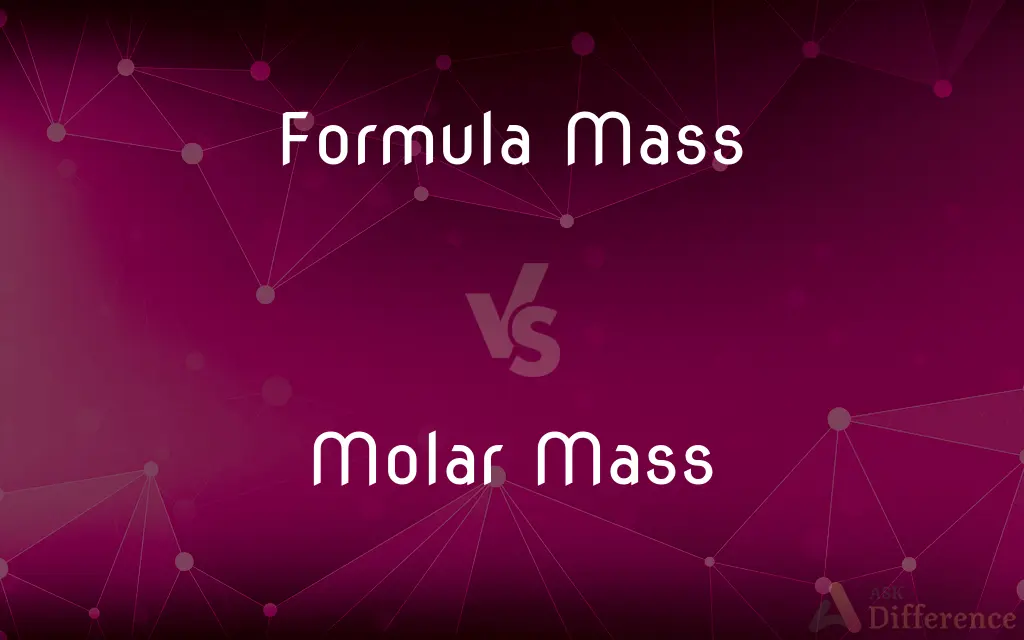Formula Mass vs. Molar Mass — What's the Difference?
By Tayyaba Rehman — Published on October 13, 2023
Formula Mass refers to the sum of atomic masses in a formula unit, often used for ionic compounds. Molar Mass is the mass of one mole of a substance, typically in grams/mol, and applies to all substances.

Difference Between Formula Mass and Molar Mass
Table of Contents
ADVERTISEMENT
Key Differences
Formula Mass and Molar Mass are fundamental concepts in chemistry, but they cater to different aspects. Formula Mass is primarily used to describe the sum of atomic masses in a formula unit, especially for ionic compounds. This gives scientists a way to express the weight of one molecule or formula unit of an ionic compound, considering its constituent ions.
Molar Mass, on the other hand, is a broader concept and pertains to the mass of one mole of a substance. It's typically expressed in grams per mole (g/mol). Every substance, whether it's an element, a molecular compound, or an ionic compound, has a molar mass. This concept bridges the microscopic world of atoms and molecules to the macroscopic world we observe.
When working with ionic compounds, it's common to use the term Formula Mass rather than Molar Mass because these compounds do not form discrete molecules. Instead, they form a continuous lattice. Thus, the term "molecule" doesn't quite fit, and "formula unit" is used instead.
Conversely, Molar Mass is a term you'll encounter regardless of the type of substance you're dealing with. It gives chemists a quantitative method to relate the number of moles of a substance to its mass in grams, a fundamental relationship in stoichiometry.
To wrap it up, while both terms deal with masses in chemistry, Formula Mass is specific to formula units of ionic compounds, and Molar Mass relates to the mass of one mole of any substance, be it an element, molecular compound, or ionic compound.
ADVERTISEMENT
Comparison Chart
Definition
Sum of atomic masses in a formula unit
Mass of one mole of a substance
Application
Typically for ionic compounds
Applies to all substances
Units
Atomic mass units (amu) or unified atomic mass units (u)
Grams per mole (g/mol)
Example
NaCl's formula unit
One mole of carbon-12 atoms
Relationship to Avogadro's Number
Doesn't directly relate
Directly related, as it's the mass of Avogadro's number of entities
Compare with Definitions
Formula Mass
Formula Mass is the sum of atomic weights in a formula unit.
The formula mass of NaCl is the sum of the atomic weights of sodium and chlorine.
Molar Mass
Molar Mass is the weight of one mole of a substance.
The molar mass of carbon is 12.01 g/mol, corresponding to one mole of carbon atoms.
Formula Mass
Formula Mass is typically used for ionic compounds.
Calcium chloride's formula mass helps in determining its quantity in a mixture.
Molar Mass
Molar Mass applies to elements, molecular compounds, and ionic compounds.
The molar mass of H2SO4 helps in laboratory preparations.
Formula Mass
Formula Mass aids in understanding compound composition.
By knowing the formula mass of MgO, chemists can deduce its atomic components.
Molar Mass
Molar Mass is measured in grams per mole (g/mol).
Oxygen's molar mass is 16.00 g/mol.
Formula Mass
Formula Mass reflects the weight of a compound's formula unit.
The formula mass of K2SO4 provides insight into its ionic structure.
Molar Mass
Molar Mass serves as a bridge between the atomic and macroscopic worlds.
Using the molar mass of a compound, we can convert between grams and moles.
Formula Mass
Formula Mass can be given in atomic mass units (amu).
The formula mass of water (H2O) is approximately 18 amu.
Molar Mass
Molar Mass is crucial for stoichiometric calculations.
Knowing the molar mass of NaOH is essential for its precise measurement in reactions.
Common Curiosities
Why is Molar Mass important in chemistry?
Molar Mass helps relate the number of moles of a substance to its mass in grams, vital for stoichiometry.
How do Formula Mass and Molar Mass differ in application?
Formula Mass is mostly used for ionic compounds, while Molar Mass applies to all substances.
What is Molar Mass?
Molar Mass is the mass of one mole of a substance, typically expressed in grams per mole.
How is Molar Mass determined?
Molar Mass is calculated by summing the atomic masses of all atoms in a compound, based on its formula.
Can Molar Mass be used to determine the number of moles in a given mass of a substance?
Yes, by dividing the given mass by the substance's molar mass.
Can Formula Mass be considered a type of Molar Mass?
No, Formula Mass pertains to a formula unit, while Molar Mass pertains to a mole of entities.
Why use the term "Formula Mass" for ionic compounds?
Ionic compounds form a continuous lattice, not discrete molecules, so "formula unit" is more appropriate than "molecule."
Is Molar Mass constant for all isotopes of an element?
No, different isotopes have different masses, affecting the molar mass.
Why is it crucial to know the Molar Mass in chemical reactions?
Knowing the Molar Mass ensures accurate measurement of reactants and products in stoichiometric calculations.
What is Formula Mass?
Formula Mass is the sum of atomic masses in a formula unit, primarily used for ionic compounds.
Does Formula Mass change with physical states?
No, Formula Mass remains constant regardless of a substance's physical state.
Do Formula Mass and Molar Mass have the same units?
No, Formula Mass is often in amu, while Molar Mass is in g/mol.
How do chemists utilize Formula Mass in practical scenarios?
Formula Mass helps in calculations involving ionic compounds, like determining their quantity in mixtures.
Is the concept of Molar Mass related to Avogadro's Number?
Yes, Molar Mass represents the mass of Avogadro's number of entities of a substance.
Does Formula Mass provide insight into molecular structure?
Formula Mass, for ionic compounds, reflects their ionic structure, not molecular structure.
Share Your Discovery

Previous Comparison
Dividend vs. EPS
Next Comparison
Revaluation Account vs. Realisation AccountAuthor Spotlight
Written by
Tayyaba RehmanTayyaba Rehman is a distinguished writer, currently serving as a primary contributor to askdifference.com. As a researcher in semantics and etymology, Tayyaba's passion for the complexity of languages and their distinctions has found a perfect home on the platform. Tayyaba delves into the intricacies of language, distinguishing between commonly confused words and phrases, thereby providing clarity for readers worldwide.












































